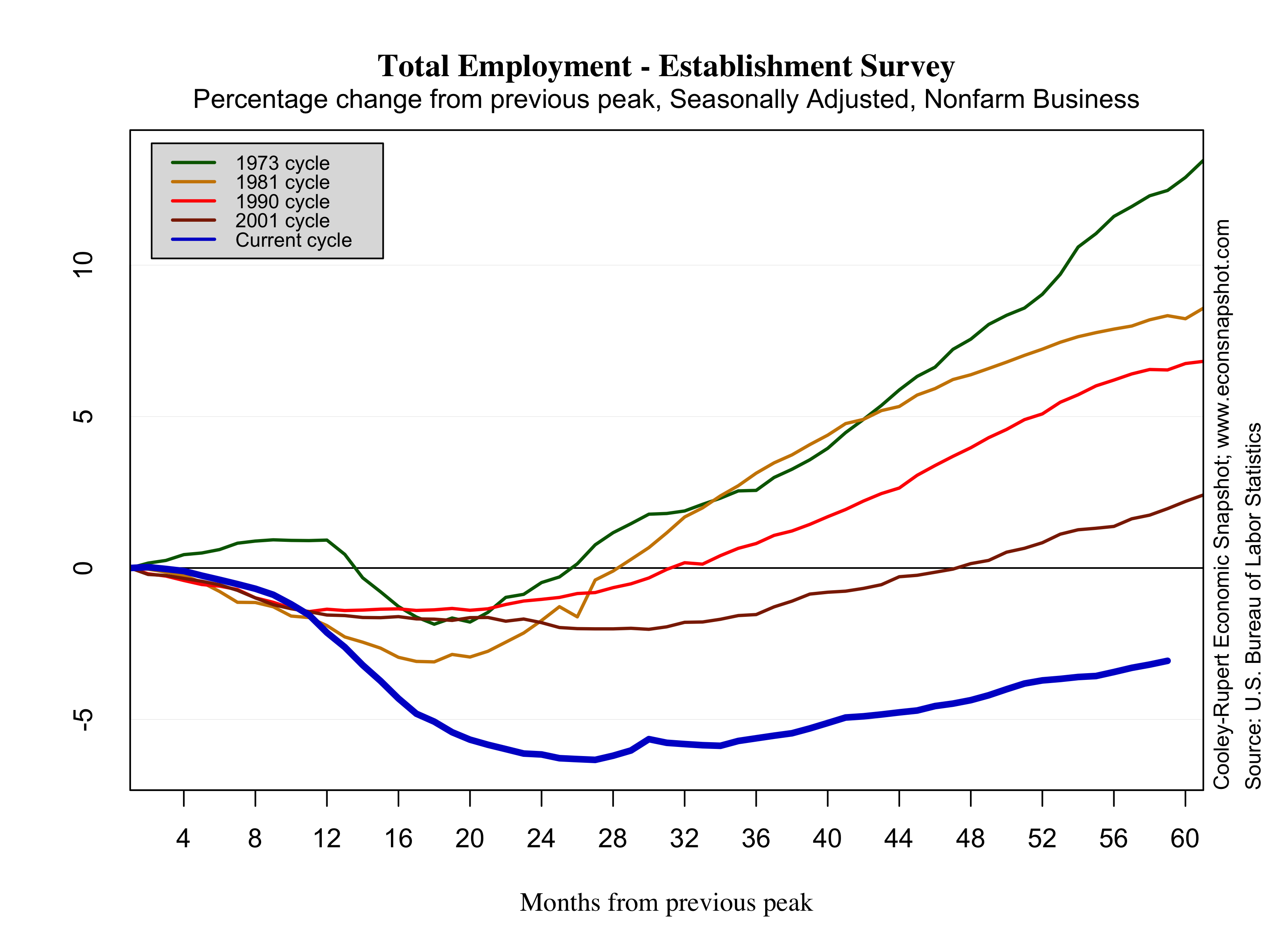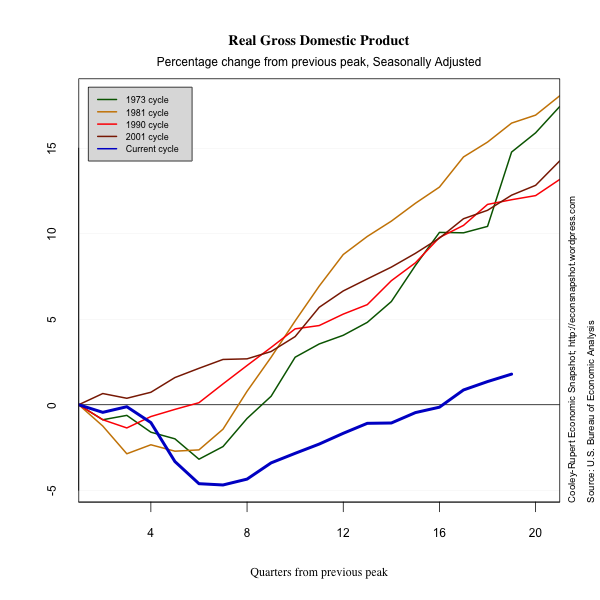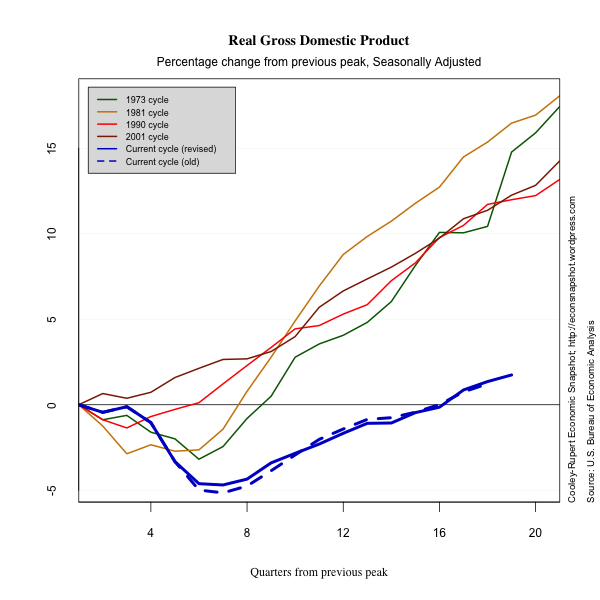Recently there has been much attention surrounding the behavior of labor’s share of income. Although it seems like it should be completely straightforward, the measurement of labor’s share is a bit tricky. As was pointed out by Tim Worstall, a contributor to Forbes, this problem is “geeky.”
The issue has been raised again in a recent article out of the Federal Reserve Bank of Cleveland’s Economic Commentary series, Labor’s Declining Share of Income and Rising Inequality, by Jacobson and Occhino. Evidently, some of their underlying calculations were taken from a paper Paul Gomme and I wrote years back, Measuring Labor’s Share of Income, also from the Cleveland Fed. In that paper we carefully described the calculations for measuring labor’s share and compared that to the measure employed by the Bureau of Labor Statistics.
Jacobson and Occhino mention that their calculations were based on the work Gomme and I did but they neglect important components in the calculation. Below we show four different measures including the Occhino-Jacobson and Gomme-Rupert measures.
So, what is the cause of the discrepancy? Here is the geeky part. There are some things that are obviously returns to labor income, for example, wage and salary income, call this unambiguous labor income. Similarly, there is unambiguous capital income, like the returns to owning an office building. Therefore, we can determine how much of this unambiguous income goes to labor and how much to capital. One geeky problem arises due to “ambiguous” income. For example, think of a sole proprietor. Some of the income of this proprietor is a return to labor (the hours spent working) and some will be a return to the capital owned by the proprietor (computer, store scanner, etc). In the data these are not broken out separately. Accepted practice is to allocate shares of ambiguous income to labor and capital in the same proportion as derived from the unambiguous incomes. In the end, labor’s share is obtained by dividing unambiguous labor income by total unambiguous income (that is, unambiguous labor income and unambiguous capital income).
Here’s where things get really geeky. The problem with the Jacobson and Occhino calculation is that they neglected to make adjustments for the government and the housing sectors. In the data there is no capital income series for the government. All income for that sector appears as wage income to government workers. While the housing sector does break out the two, it also includes a source of capital income (imputed rent to owner-occupied housing) for which there is no corresponding labor income.. Paul Gomme and I recently redid the calculations and the results are shown in the Figure below. The “Raw NIPA data” line in the graph turns is the line that Jacobson and Occhino report, the last data point being 63.8%. Once the adjustment to the housing and government sectors are taken into account, it is evident that labor’s share moves around its long run average – there does not appear to be a downward trend. Note that all of the measures show that labor’s share is currently below its long run average, as it will be from time to time. In the graph below we plot the data starting in 1929 (Jacobson and Occhino started in 1947) because that is the earliest data available from the National Income and Product Accounts (NIPA).
the fall in labor’s share since 1970 identified by Jacobson-Occhino is precisely because they didn’t do the adjustments for the government and housing sectors that we implicitly told them they should do. From 1970 to 2011, the gap between the Gomme-Rupert measure of labor’s share of income and Jacobson-Occhino’s rises from around 3 percentage points to 4.5 percentage points, or a rise of 1.5 percentage points. If you add the government wages and salaries into the Gomme-Rupert calculation, the gap rises from 10.5 percentage points to 11.5 percentage points for a rise of 1 percentage point. This increase reflects the well-known (?) fall in the share of government wages and salaries in income. If instead, you add housing income flows to the Gomme-Rupert calculation, the rise is from 5.5 percentage points to 6.6 percentage points, or a rise of 1.1 percentage points. This latter increase is due to a less well known increase in housing sector capital income’s share of GDP. Whether this latter increase can be attributed to rising housing prices– 2009 represents a high for housing capital income as a share of GDP; it falls in 2010 and falls further in 2011–is not that clear. These observations make me suspicious that movements in this series are driven in large part by housing prices.
The principle difference is that for Jacobson and Occhino, labor’s share is below its long run average almost every year since 1980 (there are a handful of years where the share is essentially at its mean) whereas the Gomme-Rupert series still looks like it’s fluctuating around its long term average. It may be premature to declare a long term decline in labors share.

Continue reading “Is Labor’s Share of Income Declining?” →















